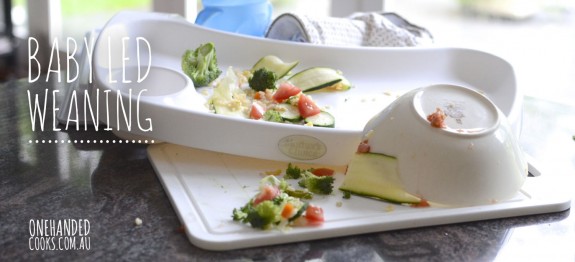Baby Led Weaning
You may have heard the term baby-led weaning (BLW) being thrown around lately? Essentially, baby-led weaning is a way of introducing solid foods that allows babies to feed themselves without the need for spoons or pureed food of any kind. Baby-led weaning involves the baby in all aspects of eating with the family, as they are invited to join in whenever they are ready.
The key idea of BLW is that babies are ready for solid food at 6 months of age. By this time your baby can most likely sit upright, pick up pieces of food, take them to his mouth and chew. These skills enable babies to feed themselves, so by delaying solids till 6 months you essentially skip the puree stage altogether.
The baby-led weaning craze has many people divided. Some love the idea, others can’t understand it, and many feel they have been doing it for years, just without the fancy name. There is an abundance of BLW information online and it is easy to be overwhelmed, you may find the simplest outline provided by the BLW creator Gill Rapley.
Choosing appropriate foods:
The baby-led weaning concept allows your baby to share most healthy family foods with you. It is advised to choose foods that can be cut into larger sticks or strips. Offering a wide variety of food is key, so your baby can gain all the important nutrients they need.
Appropriate healthy foods:
– Fruit
– Vegetables
– Meat
– Cheese
– Well cooked eggs
– Bread
– Rice
– Pasta
– Most low mercury fish
Have realistic expectations:
The control freak inside you will want to see a decent amount of food being consumed, and this is a key reason why many don’t continue with BLW. However, with baby-led weaning you wont have that control. Try not to expect too much for at least the first few months.
– Think of mealtimes as exploration, or play sessions at first.
– Expect a great deal of mess
– Have fun, your baby will thrive on your enthusiasm and look forward to trying new foods
Safety:
As with all finger foods, there are some risks. Those risks can be avoided by taking simple precautions:
– Make sure your baby is sitting upright to eat
– Don’t give your baby whole nuts or hard inappropriate foods
– Cut small fruits such as cherries in half and remove any pips
– Don’t let anyone except your baby put food into his mouth
– Explain BLW in detail to anyone caring for your baby
– Never leave your baby alone with food
Risks of choking:
Many solid food guidelines encourage the introduction of finger food at 6 months of age to help develop the all-important chewing motion. The BLW concept suggests, that provided the simple safety precautions are being met, choking is no more likely than any other method. In addition to this, many BLW activists say that allowing babies to control what goes into their mouths is in fact, a safer way of eating.
BLW basics:
Once you have done all your research and spoken to your GP you will be more than ready to see your baby attack a mound of family food. Here are the basics to get you started:
– Sit your baby upright in a highchair, facing the table.
– Offer your baby food by placing it on the tray in front of him. You can also let your baby take food from your hand.
– The first foods you provide should be easy to pick up. Think long thick sticks.
– Introduce new shapes and textures gradually, give your baby a chance to handle new food at his own pace.
– Where possible, try and offer your baby the foods you are eating. Including your baby in family mealtimes is ideal so he can copy you.
– Pick the moment to try new food wisely; a happy, awake baby will be more likely to experiment.
– Continue breast or formula milk feeds as normal; this is your baby’s key form of nutrition at this stage.
– Try not to rush your baby or distract him while he is experimenting with food.
– Offer your baby water while he is eating.
– Don’t allow anyone else to ever put food in your baby’s mouth.
Including BLW in our recipes:
The concept of BLW states no pureed food, but you can still use the recipe ideas and flavours on our page. Use your own creativity and a bit of freehand modification. For example, you can use the flavours and preparation of each recipe as a guide, just skip the puree or mashing step, chop each element into appropriate strips and serve straight to your baby.
Finally, as with all introduction to solid methods, you should discuss your individual circumstances with your health care advisors. This is particularly important If you have a family history of food intolerance, allergy or digestive problems
Like the idea of spoon feeding and early introduction of finger foods? You might like our Tasting Plate method.
Join us on Facebook for other foodie bits and pieces.
















